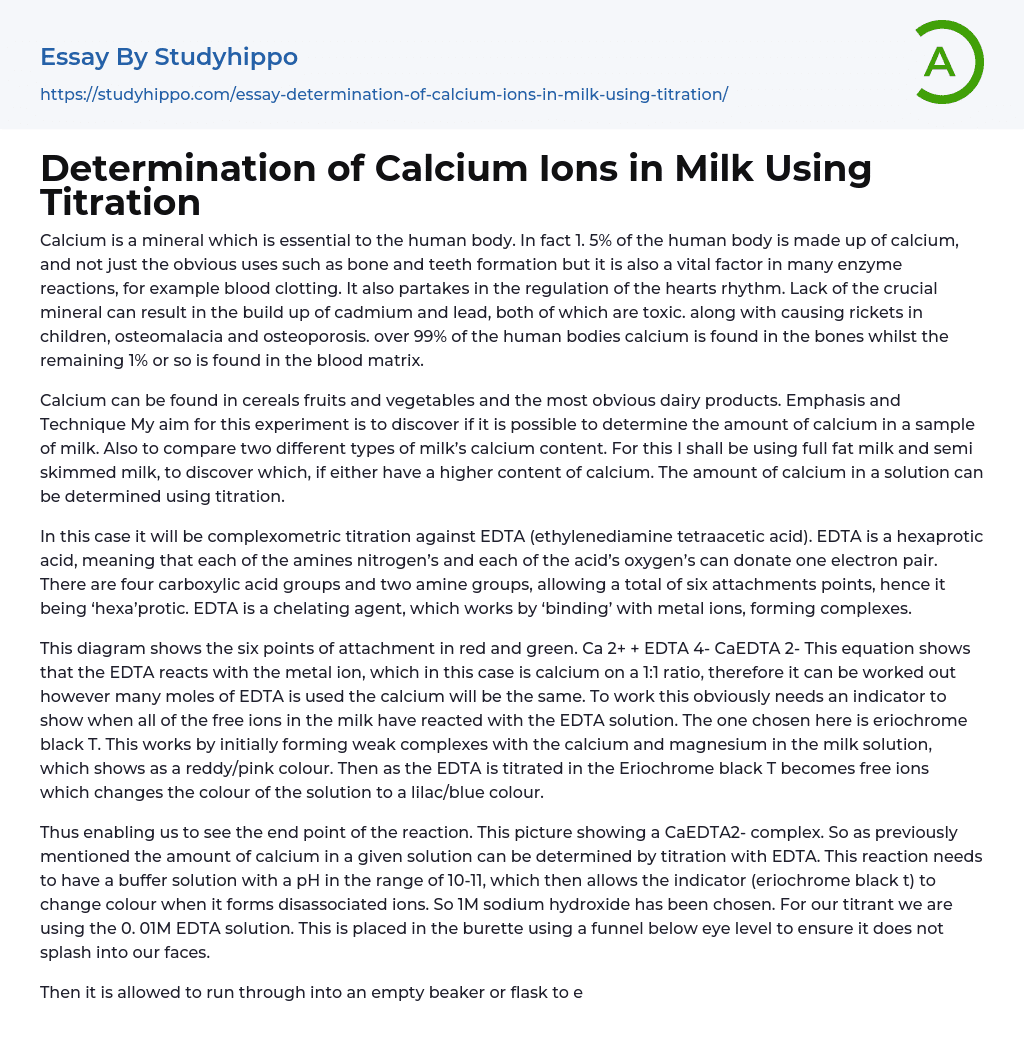

Determination of Calcium Ions in Milk Using Titration Essay Example
Calcium is a mineral which is essential to the human body. In fact 1. 5% of the human body is made up of calcium, and not just the obvious uses such as bone and teeth formation but it is also a vital factor in many enzyme reactions, for example blood clotting. It also partakes in the regulation of the hearts rhythm. Lack of the crucial mineral can result in the build up of cadmium and lead, both of which are toxic. along with causing rickets in children, osteomalacia and osteoporosis. over 99% of the human bodies calcium is found in the bones whilst the remaining 1% or so is found in the blood matrix.
Calcium can be found in cereals fruits and vegetables and the most obvious dairy products. Emphasis and Technique My aim for this experiment is to disco
...ver if it is possible to determine the amount of calcium in a sample of milk. Also to compare two different types of milk’s calcium content. For this I shall be using full fat milk and semi skimmed milk, to discover which, if either have a higher content of calcium. The amount of calcium in a solution can be determined using titration.
In this case it will be complexometric titration against EDTA (ethylenediamine tetraacetic acid). EDTA is a hexaprotic acid, meaning that each of the amines nitrogen’s and each of the acid’s oxygen’s can donate one electron pair. There are four carboxylic acid groups and two amine groups, allowing a total of six attachments points, hence it being ‘hexa’protic. EDTA is a chelating agent, which works by ‘binding’ with metal ions, forming
complexes.
This diagram shows the six points of attachment in red and green. Ca 2+ + EDTA 4- CaEDTA 2- This equation shows that the EDTA reacts with the metal ion, which in this case is calcium on a 1:1 ratio, therefore it can be worked out however many moles of EDTA is used the calcium will be the same. To work this obviously needs an indicator to show when all of the free ions in the milk have reacted with the EDTA solution. The one chosen here is eriochrome black T. This works by initially forming weak complexes with the calcium and magnesium in the milk solution, which shows as a reddy/pink colour. Then as the EDTA is titrated in the Eriochrome black T becomes free ions which changes the colour of the solution to a lilac/blue colour.
Thus enabling us to see the end point of the reaction. This picture showing a CaEDTA2- complex. So as previously mentioned the amount of calcium in a given solution can be determined by titration with EDTA. This reaction needs to have a buffer solution with a pH in the range of 10-11, which then allows the indicator (eriochrome black t) to change colour when it forms disassociated ions. So 1M sodium hydroxide has been chosen. For our titrant we are using the 0. 01M EDTA solution. This is placed in the burette using a funnel below eye level to ensure it does not splash into our faces.
Then it is allowed to run through into an empty beaker or flask to ensure the air from the tip of the burette is purged. To
make our aliquot we firstly, using a pipette, place15ml of milk in a flask, which is then diluted to approximately 100ml using distilled water. Then 10ml of the 1M sodium hydroxide solution is added to provide the pH range necessary. Next added is 3 to 4 drops of the indictor. Then this solution is ready to titrate with the EDTA. Starting at a red colour and ending at a lilac colour as the end point is reached.
- Acid essays
- Calcium essays
- Carbohydrate essays
- Carbon essays
- Chemical Bond essays
- Chemical Reaction essays
- Chemical reactions essays
- Chromatography essays
- Concentration essays
- Copper essays
- Diffusion essays
- Ethanol essays
- Hydrogen essays
- Organic Chemistry essays
- Osmosis essays
- Periodic Table essays
- Ph essays
- Salt essays
- Sodium essays
- Titration essays
- Anorexia essays
- Breakfast essays
- Caffeine essays
- Chewing gum essays
- Child Development essays
- Chocolate essays
- Diet essays
- Dieting essays
- Eating essays
- Eating Habits essays
- Energy Drink essays
- Food essays
- Genetically Modified Food essays
- Genetically Modified Organisms essays
- Junk Food essays
- Metabolism essays
- Milk essays
- vegetarian essays
- Vitamin essays
- Weight Loss essays



